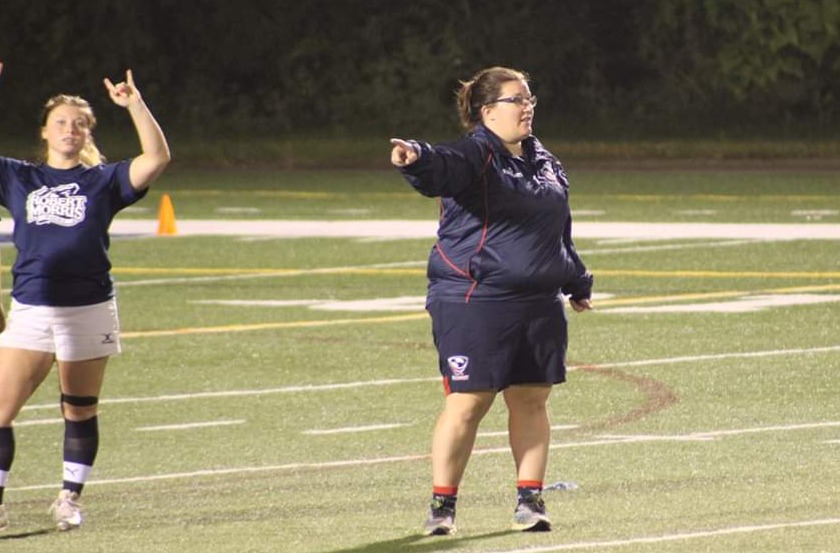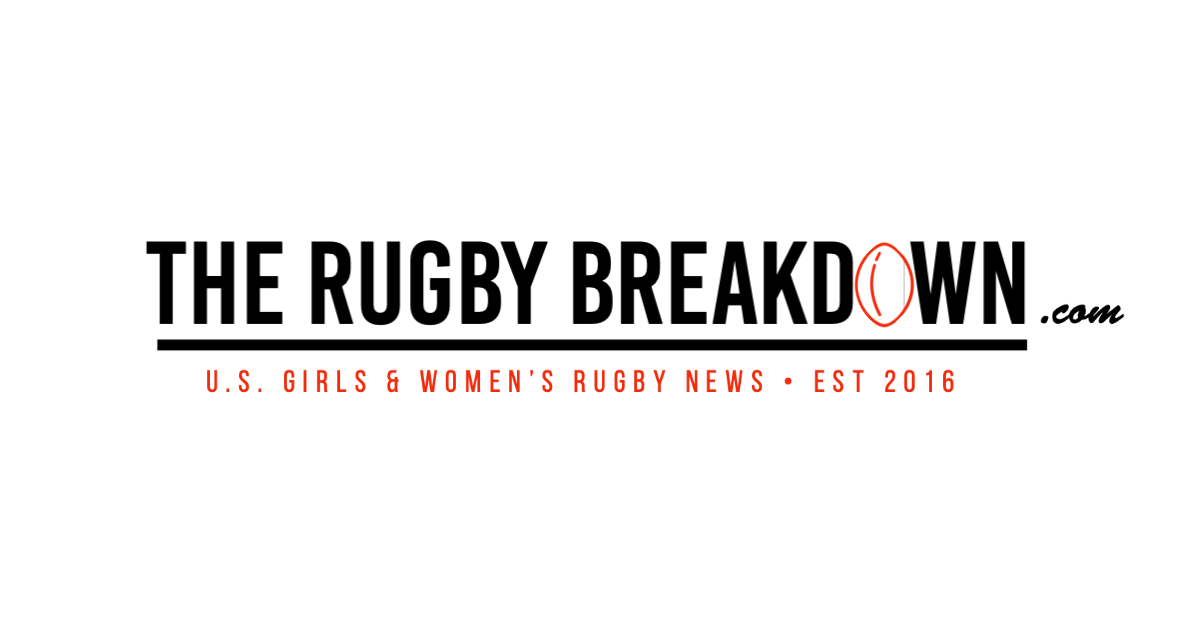
Smarto coaching Robert Morris Univ / Photo: Nate Feldhouse
The National Collegiate Rugby Organization (NCRO) named its Women’s Open Division Commissioner on Wednesday, and shortly after the announcement, TRB was messaging Angela Smarto for an interview.
“insane proposal – ready now? my wife is at work and if she doesn’t have to listen to an hour-long rugby call she would love that lol,” Smarto wrote back.
That’s the request of – first and foremost – a considerate spouse but also someone who’s in the thick of it. It’s why Smarto, who teaches at a virtual school during regular hours, concentrated her work load on Tuesdays and Thursdays, so the rest of the week could handle the demands of rugby, the second job.
READ MORE about Smarto’s background
Smarto played rugby at Penn State and coaches Allegheny Rugby Union (ARU) select sides and Robert Morris University, a National Small College Rugby Organization (NSCRO) program that struggles for numbers. She understands the competitive spectrum of collegiate teams, and that perspective has been very useful while serving as the Allegheny women’s conference commissioner. The competition is unique in that it includes DI, DII and NSCRO teams (a hybrid league typically involves two of the three distinctions). Teams play across divisions, there are options for fall 7s if that’s where a program finds itself, and the set-up reflects an administrator who appreciates the many motivations for playing the sport.

2012 Keystone Tournament with Penn State
Bryn Chivers, the NSCRO women’s commissioner, is also sensitive to the fragility of college teams, and familiarized himself with Smarto when Allegheny went hybrid a few years ago.
“I’ve always had a quality experience with NSCRO. I never worried about my small schools,” said Smarto, who juxtaposed NSCRO and USA Rugby, the DI and DII teams’ organizing body. “NSCRO always had playoff dates and locations ready by September. ‘Your season needs to be done by this date so we can plan regionals for this date.’ We always had all our information for all-stars. In DI and DII, it was e-mails of, ‘What’s happening? I don’t know.’ Or, ‘Sorry, IUP, you have to drive to Missouri in five days [for playoffs].’
“NSCRO is all about the player experience and feasible, transparent communication. And any time you have a question, the contact is always Bryn,” Smarto continued. “At USA Rugby, it was, ‘Try Membership [with your question], but you might actually need to talk to someone else.’ Or, ‘CC both departments and between the four of them you might get an answer.’ It was always operationally challenging.
“I never felt like I was fighting The Man working with NSCRO,” Smarto summarized. “My small schools didn’t have to worry about what the DI and DII teams worried about.”

RMU, fall 2020
Life would have been easier if her three sets of teams followed the same governance, but Smarto was able to preview what that process – moving an entire conference to another organization – might look like. In late fall 2019, men’s DII colleges in the Pittsburgh and West Virginia region left their geographically distant conferences and got together to form a new, local competition. Smarto reached out to see if they’d be interested in rejoining the ARU, where their women’s teams resided. Todd Streeter, member of the USA Rugby Men’s College Competitions Committee, invited her to the DII commissioners’ conference calls, which occurred every three weeks.
“Those guys are friggin’ organized,” Smarto said. “Everyone knew everyone – their names, their teams, their competitions – everything. You hear that joke, that women are more organized when it comes to these things, but not in this case.”
In December, NSCRO announced intentions to expand its services beyond the small-school realm.
“They saw the writing on the wall. ‘I think we should move to NSCRO,’” Smarto said of the DII commissioners’ consensus. “They painstakingly fought it all out for weeks but when they made their decision [to leave USA Rugby], they were able to step forward together.”
After that experience, Smarto looked at the set-up of the women’s college conferences. There was no framework that connected league leaders and promoted their communication and coordination. Smarto realized she had never participated in a conference call with neighboring Ohio Valley or Upstate New York, and that leagues all over the country intertwined geographically but were isolated from each other. So when USA Rugby declared bankruptcy, and individual conferences had to decide what steps to take next, the process looked nothing like that of the men’s DII colleges.
“When it came time to make a big decision together, we were not prepared,” Smarto said.
Smarto had three futures to consider. The small schools were covered in NSCRO, and the DI and DII teams were discussed separately.
“The DI commissioners had a call first and they got a priority list together,” Smarto said. “Everyone went around the room, because each conference has its own concerns – some are based on geography or how competitive they are – so there were some commonalities and also specific concerns. It was a good start, and then it was, ‘Now what do we do?’ So there was a lull for a bit.”

Allegheny all-star coaches (l-r) Rebecca Trapp, Kiyomi Knox and Smarto
The DII process was also frustrating.
“Everyone was ignoring the elephant in the room: What competitive structure should we join,” Smarto said. “Instead, people were asking broad-stroke questions or ones they already knew the answers to. It was 25 people weighing in and no decision being made.”
A DII committee did form but Smarto didn’t connect with the direction in which it was heading. And she was getting burnt out. She had been discussing realignment subject-matter since November – with the men’s teams – and kept having the same conversations with the women but with no outcomes.
So she presented the three options to her DI/II teams and asked them to rank their preferences going forward: Stay with USA Rugby in a wait-and-see scenario; join NSCRO’s new NCRO Open Division; or join the College Rugby Association of America, a competition that would still be tied to USA Rugby. NSCRO / NCRO was the unanimous decision.
Smarto was relieved. Her questions had been answered and everyone was back under one roof. The student-run clubs were happy that a decision was made before the summer commenced and looked forward to the promise of a quality product.
“And if it’s good enough for Winona State – if that’s the level of competition – then it’s good enough for us,” Smarto said of the reigning DII fall champion whose hybrid conference, Northern Lights, was the first to officially send its DII teams to NCRO. “They’re my benchmark now.”

Photo: Emily Ramsey (l), Kiyomi Knox (r)
Another three women’s conferences – Great Waters, Illinois and Upstate New York – announced their alignment with NCRO’s Open Division. Chivers and Smarto had been talking nearly every day, plotting out theoretical competition structures. Once Allegheny officially committed, Chivers asked Smarto about being the new competition’s commissioner and that he had been priming her for the ask.
“NSCRO is the world that Bryn has built,” Smarto said. “There are how many small schools [more than 100] and he could probably tell you something about each and every one of them. … The Open Division is the sister world to that, complementary but not the same, because small schools are different and shouldn’t be done the same way necessarily.”
Like Chivers is for small schools, Smarto is now the contact for all things NCRO Open Division. Her first order of business is to, “Hurry up and wait,” as teams and conferences have until May 22 to join NCRO. Once the membership is confirmed, then planning for the future will begin.
“I’ll talk to anybody. But the teams that haven’t committed [to any competition] right now already know their options,” Smarto said of promoting NCRO. “They just want to know who’s going to represent them, because it has been a mystery for some teams. Bryn won’t do it because he already has a hundred teams, so who is going to be in charge? Now they know it’s me. I’m open to that phone call, but structurally, they already know the answers to the questions because it’s in a document available to all of the commissioners.”
Smarto did indicate that commissioners who weren’t disseminating information to their membership had individual teams calling Chivers asking for insight into NCRO, regardless of what the rest of the league was doing.
One of the most common questions revolves around the name itself: What does it mean to be an NCRO Open Division champion? While the terminology is vague, Smarto explained the opportunity inherent in such a descriptor.
“Let’s look at the teams on the USA Rugby pathways,” Smarto said of teams outside of NSCRO and NIRA. “There’s the DI Elite and there’s some stratification among those four teams there. Then you have, I’d say, 10-15 teams who are the next tier of ‘really good.’ Then everybody else. I think theoretically if you layered the DI and DII [fall playoff] brackets you could have some really good games regardless of being DI or DII. [DII] Winona State beat Minnesota in the regular season, and Minnesota finished top four in DI [fall]. That tells me the pathways to find out who’s the best team are corrupt somewhere. We’re not really finding out the best team because we’re siphoning our talent.
“Also, adding DI teams [to a DII league], how much does that really affect everything,” Smarto continued. “Do you think Winona State is threatened by lower-performing DI teams? No. So people don’t know what ‘open’ means, but I think teams aren’t self-aware of where they fall competitively.”
Smarto also sees the Open Division as an opportunity to address the fallacy that student enrollment, as the main determinant, dictates the strength of a program.
“The belief was that big schools should be able to find good athletes [and dominate], middle schools are middle, and NSCRO teams are bad – that’s just not true, but that’s how those divisions were laid out,” Smarto said. “West Virginia has [30,000] students. They had one season where they had 40 players and did well at playoffs, but then their coach got married and left, and they haven’t had a head coach since. They struggle every year. That’s what actually separates teams: how professionally they’re run.”
There is much to consider going forward, from what NCRO playoffs will look like (the final four weekend is Dec. 5-6), to how the Open Division players will incorporate into the annual all-star 7s championship (“Going to Florida in January rules.”). Smarto will assemble a competitions committee and work toward those answers.
Fortunately, Smarto has lived through a tectonic shift in competition before. Earlier this decade, USA Rugby dismantled the Territorial Unions (TUs) and dispersed their administration to different sectors of the game. Some college competitions flailed as they attempted to replace that structure and leadership.
“Is it another 2012-13, where we break up into fiefdoms and some work and some don’t? That’s is bad for the game,” Smarto said. “When the TUs broke up they didn’t provide any longitudinal direction [for the colleges]. ‘You need to form a conference, elect a commissioner, establish playoffs.’ The colleges were on their own and not all of them survived. You see it. Teams have fallen apart since then because they didn’t have the administrative support that once came from the TUs, and there’s been a decline in the game.
“I want to be the same administrator that I am for my local teams to all these teams as well,” Smarto concluded. “All commissioners are volunteers, and likely coaches of one of the member teams. They just don’t want to be blindsided by anything; they want their teams to be taken care of.”


